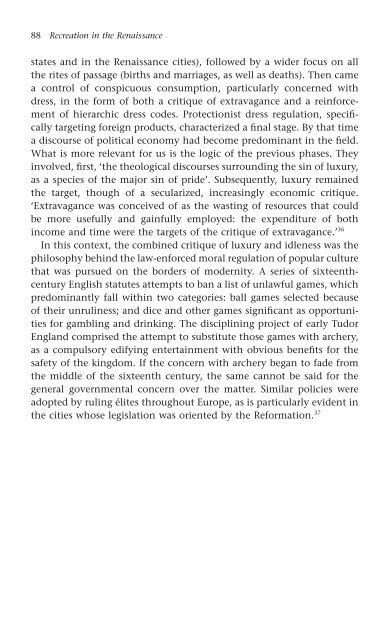Recreation in the Renaissance
Recreation in the Renaissance
Recreation in the Renaissance
- No tags were found...
Create successful ePaper yourself
Turn your PDF publications into a flip-book with our unique Google optimized e-Paper software.
88 <strong>Recreation</strong> <strong>in</strong> <strong>the</strong> <strong>Renaissance</strong><br />
states and <strong>in</strong> <strong>the</strong> <strong>Renaissance</strong> cities), followed by a wider focus on all<br />
<strong>the</strong> rites of passage (births and marriages, as well as deaths). Then came<br />
a control of conspicuous consumption, particularly concerned with<br />
dress, <strong>in</strong> <strong>the</strong> form of both a critique of extravagance and a re<strong>in</strong>forcement<br />
of hierarchic dress codes. Protectionist dress regulation, specifically<br />
target<strong>in</strong>g foreign products, characterized a f<strong>in</strong>al stage. By that time<br />
a discourse of political economy had become predom<strong>in</strong>ant <strong>in</strong> <strong>the</strong> field.<br />
What is more relevant for us is <strong>the</strong> logic of <strong>the</strong> previous phases. They<br />
<strong>in</strong>volved, first, ‘<strong>the</strong> <strong>the</strong>ological discourses surround<strong>in</strong>g <strong>the</strong> s<strong>in</strong> of luxury,<br />
as a species of <strong>the</strong> major s<strong>in</strong> of pride’. Subsequently, luxury rema<strong>in</strong>ed<br />
<strong>the</strong> target, though of a secularized, <strong>in</strong>creas<strong>in</strong>gly economic critique.<br />
‘Extravagance was conceived of as <strong>the</strong> wast<strong>in</strong>g of resources that could<br />
be more usefully and ga<strong>in</strong>fully employed: <strong>the</strong> expenditure of both<br />
<strong>in</strong>come and time were <strong>the</strong> targets of <strong>the</strong> critique of extravagance.’ 36<br />
In this context, <strong>the</strong> comb<strong>in</strong>ed critique of luxury and idleness was <strong>the</strong><br />
philosophy beh<strong>in</strong>d <strong>the</strong> law-enforced moral regulation of popular culture<br />
that was pursued on <strong>the</strong> borders of modernity. A series of sixteenthcentury<br />
English statutes attempts to ban a list of unlawful games, which<br />
predom<strong>in</strong>antly fall with<strong>in</strong> two categories: ball games selected because<br />
of <strong>the</strong>ir unrul<strong>in</strong>ess; and dice and o<strong>the</strong>r games significant as opportunities<br />
for gambl<strong>in</strong>g and dr<strong>in</strong>k<strong>in</strong>g. The discipl<strong>in</strong><strong>in</strong>g project of early Tudor<br />
England comprised <strong>the</strong> attempt to substitute those games with archery,<br />
as a compulsory edify<strong>in</strong>g enterta<strong>in</strong>ment with obvious benefits for <strong>the</strong><br />
safety of <strong>the</strong> k<strong>in</strong>gdom. If <strong>the</strong> concern with archery began to fade from<br />
<strong>the</strong> middle of <strong>the</strong> sixteenth century, <strong>the</strong> same cannot be said for <strong>the</strong><br />
general governmental concern over <strong>the</strong> matter. Similar policies were<br />
adopted by rul<strong>in</strong>g élites throughout Europe, as is particularly evident <strong>in</strong><br />
<strong>the</strong> cities whose legislation was oriented by <strong>the</strong> Reformation. 37










